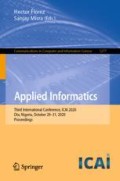Abstract
Nowadays, there are different digital tools that permit the editing of digital content as audio files and they are easily accessed in mobile devices and personal computers. Audio forgery detection has been one of the main topics in the forensics field, as it is necessary to have reliable evidence in court. These audio recordings that are used as digital evidence may be forged and methods that are able to detect if they have been forged are required as new ways of generation of fake content continue growing. One method to generate fake content is imitation, in which a speaker can imitate another, using signal processing techniques. In this work, a passive forgery detection approach is proposed by manually extracting the entropy features of original and forged audios created using an imitation method and then using a machine learning model with logistic regression to classify the audio recordings. The results showed an accuracy of 0.98 where all forged audios were successfully detected.
Access this chapter
Tax calculation will be finalised at checkout
Purchases are for personal use only
References
Digital evidence|NIST. https://www.nist.gov/topics/digital-evidence. Accessed 05 Nov 2019
A Simplified Guide To Forensic Audio and Video Analysis. http://www.forensicsciencesimplified.org/av/AudioVideo.pdf. Accessed 28 Aug 2019
ANSI National Accreditation Board|ANAB. https://www.anab.org/. Accessed 26 Aug 2019
Teerakanok, S., Uehara, T.: Digital media tampering detection techniques: an overview. In: Proceedings of IEEE 41st Annual Computer Software and Applications Conference, pp. 170–174. https://doi.org/10.1109/COMPSAC.2017.109, https://doi.org/10.1109/COMPSAC.2017.109
Imran, M., Ali, Z., Bakhsh, S.T., Akram, S.: Blind detection of copy-move forgery in digital audio forensics. IEEE Access, 12843–12855. https://doi.org/10.1109/ACCESS.2017.2717842
Ali, Z., Imran, M., Alsulaiman, M.: An automatic digital audio authentication/forensics system. IEEE Access, 2994–3007. https://doi.org/10.1109/ACCESS.2017.2672681
Chen, J., Xiang, S., Huang, H., Liu, W.: Detecting and locating digital audio forgeries based on singularity analysis with wavelet packet. Multimedia Tools Appl. 75(4), 2303–2325 (2014). https://doi.org/10.1007/s11042-014-2406-3
Ballesteros, D.M., Moreno, J.M.: Highly transparent steganography model of speech signals using Efficient Wavelet Masking. Expert Syst. Appl. 39(10), 9141–9149. https://doi.org/10.1016/j.eswa.2012.02.066
Goodfellow, I.J., et al.: Generative adversarial networks, pp. 1–9. https://arxiv.org/abs/1406.2661
Audio Generation with GANs - Neuronio - Medium. https://medium.com/neuronio/audio-generation-with-gans-428bc2de5a89. Accessed 16 Sept 2019
Ning, Y., He, S., Wu, Z., Xing, C., Zhang, L.-J.: Review of deep learning based speech synthesis. Appl. Sci. 9(19), 1–16. https://doi.org/10.3390/app9194050
NBA Warif et al.: Copy-move forgery detection: survey, challenges and future directions. J. Netw. Comput. Appl., 259–278 (2016). https://doi.org/10.1016/j.jnca.2016.09.008
Gul, E., Ozturk, S.: A novel hash function based fragile watermarking method for image integrity. Multimedia Tools Appl. 78(13), 17701–17718 (2019). https://doi.org/10.1007/s11042-018-7084-0
Milani, S., Piazza, P.F., Bestagini, P., Tubaro, S.: Audio tampering detection using multimodal features, 4563–4567. https://doi.org/10.1109/ICASSP.2014.6854466
Cuccovillo, L., Mann, S., Tagliasacchi, M., Aichroth, P.: Audio tampering detection via microphone classification. In: 2013 IEEE International Workshop on Multimedia Signal Processing. MMSP 2013, pp. 177–182 (2013). https://doi.org/10.1109/MMSP.2013.6659284
Xie, Z., Lu, W., Liu, X., Xue, Y., Yeung, Y.: Copy-move detection of digital audio based on multi-feature decision. J. Inf. Secur. Appl., 37–46. https://doi.org/10.1016/j.jisa.2018.10.003
Pan, X., Zhang, X., Lyu, S.: Detecting splicing in digital audios using local noise level estimation. In: ICASSP, IEEE International Conference on Acoustics, Speech and Signal Processing - Proceedings, pp. 1841–1844. https://doi.org/10.1109/ICASSP.2012.6288260
Isak-Zatega, S., Lipovac, A., Lipovac, V.: Logistic regression based in-service assessment of mobile web browsing service quality acceptability. EURASIP J. Wireless Commun. Netw. 2020(1), 1–21 (2020). https://doi.org/10.1186/s13638-020-01708-2
Javed, A., Ejaz, A., Liaqat, S., Ashraf, A., Ihsan, M.B.: Automatic target classifier for a ground surveillance radar using linear discriminant analysis and logistic regression. In: European Microwave Week 2012: “Space for Microwaves”, EuMW 2012, Conference Proceedings, pp. 302–305 (2012)
Goodfellow, I.J., Bengio, Y., Courville, A.: Deep Learning
Ballesteros, D.M., Moreno, J.M.: On the ability of adaptation of speech signals and data hiding. Expert Syst. Appl. 39(16), 12574–12579 (2012). https://doi.org/10.1016/j.eswa.2012.05.027
Shannon, C.E.: A mathematical theory of communication. Bell Syst. Tech. J.. [Online]. Available: http://www.math.harvard.edu/~ctm/home/text/others/shannon/entropy/entropy.pdf. Accessed 16 Sept 2019
Author information
Authors and Affiliations
Corresponding author
Editor information
Editors and Affiliations
Rights and permissions
Copyright information
© 2020 Springer Nature Switzerland AG
About this paper
Cite this paper
Rodríguez-Ortega, Y., Ballesteros, D.M., Renza, D. (2020). A Machine Learning Model to Detect Fake Voice. In: Florez, H., Misra, S. (eds) Applied Informatics. ICAI 2020. Communications in Computer and Information Science, vol 1277. Springer, Cham. https://doi.org/10.1007/978-3-030-61702-8_1
Download citation
DOI: https://doi.org/10.1007/978-3-030-61702-8_1
Published:
Publisher Name: Springer, Cham
Print ISBN: 978-3-030-61701-1
Online ISBN: 978-3-030-61702-8
eBook Packages: Computer ScienceComputer Science (R0)

